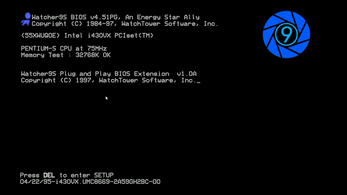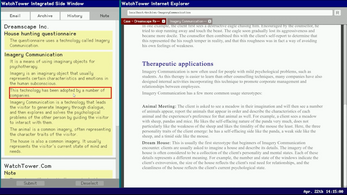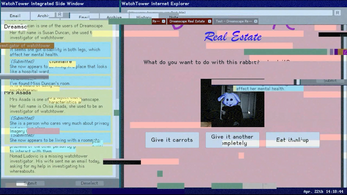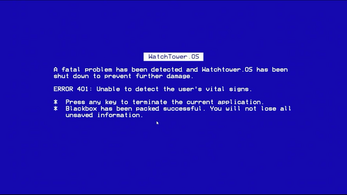Dive into the Otherside
A downloadable game for Windows
The game is recommended to be played in fullscreen mode.
Please be advised that there are some display issues if your resolution is not 1920*1080. I hope I can find a way to fix it in the future. You can also play the Windows build for the full experience.
Introduction
Dive into the Otherside is a 90s internet weirdcore game set in the early days of the graphical internet. One day in the 1990s, the otherwise safe Internet suddenly turned into a hellish place littered with horrific phenomena. These horrific phenomena, known as anomalies, use information as a medium, and the sanity of any human who observes them is severely damaged until it descends into complete madness. In some extreme examples, incomprehensible supernatural phenomena have also occurred in their presence.
Players, as the registered investigator of organisation called “WatchTower”, will investigate these anomalies and their behaviour patterns, collect valuable information and discover the solution towards them in the end.
Your objective is to explore your assigned case, find out what happened to the missing investigators, and record details of the anomalies you encountered.
Although this game looks very close to being a horror game, I didn't intentionally develop it as one. The goal of the game is to create a weird atmosphere, but controlling that level of horror is not a simple task for an open-ended game. So some players may find the game scary or not scary at all - and that's completely normal.
Inspirations
On the face of it, wierdcore, 90s retro, Cthulhu-like or even simulated horror are the more obvious options if you were to label this game. These were admittedly important references for me when developing this game, but none of them can be called sources of inspiration.
The real motive is, I am tired to read the stories that human beings are helpless in front of some "unspeakable horror beings". I have conceived stories like what if these horrible creatures had accompanied human civilization from the beginning and never hid themselves? Would they not also be overcome by us, like those behemoths that used to exist on this planet? Such stories of humans using their wits, determination and sacrifice to overcome powerful unknown supernatural beings are not uncommon, such as "SCP-1983", Level "C-324" and Level "C-185" in the back room of the Wikidot version, and that is the kind of story I want to tell.
In terms of gameplay mechanics, its core is inherited from open-ended adventure games like Herstory and Return of Obra Dinn. However, I have made slight modifications to the original framework. The interaction mechanics, on the other hand, are inspired by Hypnospace Outlaw.
In terms of theme, the game's setting is mainly inspired by the Japanese light novel "Otherside Picnic", but it also mixes elements from well-known titles such as SCP Foundation and the Backroom series.
Design Theory
Fear comes from a lack of understanding of fear itself.
—— 名不见经传的人, An investigator of urban tales "景国人粥"
All game mechanics will revolve around four Design Theories, divided into two Narrative Theories and two Mechanism Theories:
Narrative Theories
- Encounter-Investigate-Disenchant (E-I-D for short)
- Theme: Weird and Eerie, Kindness-Wisdom-Courage-Sacrifice
Mechanism Theories
- Non-linear Narrative
- Information Driven System
These design theories are extensively linked together.
For narrative theory, E-I-D is the method to tell the stories, under the theme.
On the other hand, Non-linear narrative is the way for the game to transfer information to players, while information driven system works the opposite way, enabling players to use the information they knew to apply influence to game elements, such as NPCs.
Non-Linear Narrative
The non-linear narrative here refers specifically to the open narrative game represented by Herstory. Their narrative structure usually has the following characteristics:
- Fragmented: The story in the game is usually split into chunks of varying sizes and presented to the player using one or more mechanics.
- Disordered: The game has no absolute control over the order in which players read these content.
- Exploratory: Players lend one or more mechanisms to get more out of the story through known story information.
The biggest difference between this type of nonlinear narrative and nonlinear narrative genres such as Memento is the connection between these plot chunks. This connection is constructed based on the player's own behaviour, with the player's own logic behind it. For different players, although the content of the game is the same, the different logic and interaction of players determine the different order of the plot content, thus shaping different game journeys and experiences.
Furthermore, the game used two different types of solutions towards non-linear narrative: the exploratory solution and the emergent solution.
The exploratory solution
In this solution, the player will be provided with a large amount of information. Then, the player has to extract from it himself the key points that interest him or that he thinks might advance the game, and uses an open submission system - such as the classic search box - to validate and advance the process.
When I put this solution into practice, I found that text is not an excellent medium for information. To achieve the same level of information as games such as Herstory would require a lot of text. But reading this text took far longer than watching the video, which seriously slowed down the pace of the game. The complete reliance on the player to simply tell the game what it has found also makes the whole game more like a test.
The emergent solution
In contrast, emergent solutions mechanically loosen the grip on players. Players no longer need to find out what they need from the vast amount of information available to them; the game automatically breaks this information down into bullet points for the player. The player simply needs to focus on exploring and getting as much information into view as possible. After that, the player also only has to make decisions in response to these points to advance the game.
There are several benefits to this:
- Most obviously, it directly eases the amount of reading for players. The player only has to skim the text to get the information points used to advance the game.
- This also retains a sense of exploration. The note is not the original text, after all, and it may contain omissions of information or even deliberately designed traps. The player can go back and read the original text specifically in relation to the collected notes if they are in doubt.
Information Driven System
The information driven system allows elements of the game, such as NPCs, to act according to the information they know. This allows the player to direct and even control their behaviour by passing on information.
Encounter-Investigate-Disenchant
The first two parts are similar to the usual Cthulhu investigators: humans encounter paranormal phenomena and begin an investigation into them. But unlike the latter, the Cthulhu mythology is based on the general principle of the invincibility of supernatural beings, whereas the theme I want to convey is that humans confronted with terror use their strong will and sanity as weapons to try to understand it, and ultimately to overcome it by way of understanding. I borrowed the word disenchant to describe the last part.
Mechanically, the main interactive element to achieve this effect is the rules. This understanding of the paranormal is not based on the uncovering of its nature, knowing what it is exactly, but on the exploration and understanding of its behavioural patterns and rules.
The theme of story
The theme of the game can be divided into two parts: for anomalies, the theme is weird and eerie, while for the human investigator side, the theme is sacrifice.
Anomaly: Weird and eerie
This theme was influenced by Mark Fisher's article of the same name.
Simply put, I wanted to shape a sense of eeriness in which the familiar becomes no longer familiar. This feeling is commonly found in the following subjects, but they are expressed in different ways.
- Wierdcore
- Chinese horror games
- Unfamilarised daily life
- Dependence on a specific cultural context
- The polarized, unaware malice and evil by human beings based on obsolete traditions
- Emphasize karma. Human actions are often more terrifying than curses.
- Japanese urban legends
Investigator: An anthem of Courage and Sacrifice
Sacrifice has been a common central theme in such stories. As the famous line goes: The hymn of humanity is the hymn of courage. Sacrifice and courage have always been closely related. But what I want to show in this story is that courage is not all there is to the act of sacrifice.
In this story, sacrifice encompasses the following three virtues:
- Kindness, which is the purpose of sarcrifice
- Wisdom, which enables the solution of the act, making it worth
- Courage, which brings the determination to pull the trigger
Future Ideas
In addition to the optimisation of a number of mechanisms, the main directions for the future are the following:
- Content of the player's notes. While recording facts, the notes will also allow the player to make guesses about specific entries. The player can verify this possibility later in the investigation or submit it directly at risk, as it may get somebody killed and ruined your reputation.
- Player interaction with investigator organisations. The information submitted by players will have an impact on the information in the corresponding entry on the official website - both good and bad, depending on the correctness of the information submitted by the player.
- The exchange of information between players and other investigators. This interaction can be in the form of direct interaction, for example with the corresponding NPC directly via e-mail. It may also be indirect, where all clues submitted by the player will first be entered into a discussion board where NPCs may attach comments to the player's submission and vice versa.
| Status | In development |
| Platforms | Windows |
| Rating | Rated 3.0 out of 5 stars (1 total ratings) |
| Author | WatcherNinth |
| Genre | Adventure |
| Tags | Creepy, Horror, Retro |





Comments
Log in with itch.io to leave a comment.
I loved this. Very unsettling.
this is actually incredible